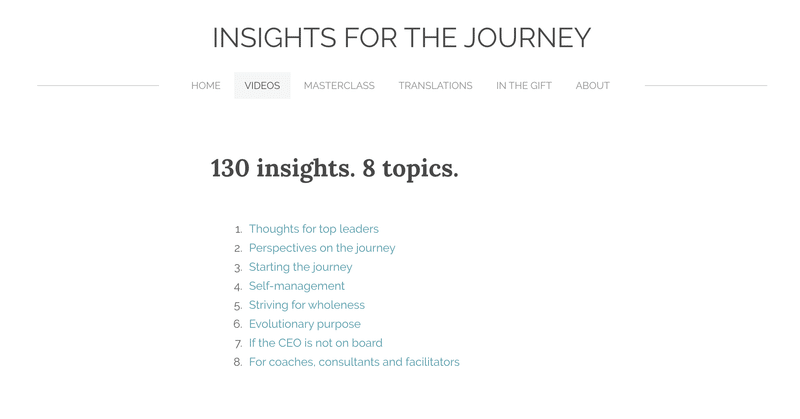
【目次】INSIGHTS FOR THE JOURNEY
英語サイトにて公開済みの数 → 131本
本マガジンにて翻訳済みの数 → 131本(100.0%)
1. Thoughts for top leaders
1.1 It’s a personal journey
1.2 What truly drives you
1.3 What hurts your integrity?
1.4 Facing your Fears
1.5 How far are you ready to go?
1.6 How do you hold the destination?
1.7 How do you hold the journey ahead?
1.8 The language you use
1.9 Know your preferences
1.10 Your roles in this new world
1.11 Holding the space in the transition
1.12 Getting support during the journey
2. Perspectives on the journey
2.1 A new way to think about change
2.2 The four quadrants: preferences & blind spots
2.3 Where to start(1)
2.4 Where to start(2)
2.5 Safe enough to try
2.6 Tension between experimentation & standardization
2.7 Is there value in reinventing the wheel?
2.8 Should you give the journey a name?
2.9 Our identity that does not change
2.10 When pent up conflict breaks out
2.11 How to work with people who resist
2.12 Reality and shadows of the transformation
2.13 Humor & Lightness
2.14 Communicating in new ways
2.15 What role for coaches, consultants and facilitators?
2.16 What role for the board?
3. Starting the journey
3.1 Building trust before you start
3.2 Test your perspective and message
3.3 Your integrity is a flashlight
3.4 Return to being a mortal
3.5 Engaging the top team
3.6 Engaging a group of first followers
3.7 Engaging the whole organization
3.8 Make old and new assumptions explicit
3.9 Invite volunteers, stop appointing
3.10 Visible first actions
3.11 Visiting other teal companies before you start?
3.12 A precise image of the future organization
4.1.Self-management / (Mis)understanding self-management
4.1.1 What does self-management mean to you?
4.1.2 Start with why
4.1.3 How to talk about it from all stages
4.1.4 So many mis-conceptions!
4.1.5 Mis-conception 1:It's risky
4.1.6 Mis-conception 2:No more structures, processes, rules
4.1.7 Mis-conception 3:No more decisions "From the top"
4.1.8 Mis-conception 4:Everyone is equal
4.1.9 Mis-conception 5:Empowerment and servant leadership
4.1.10 Mis-conception 6:Control is bad
4.1.11 Understanding self-correcting systems
4.1.12 Self-correcting systems : Examples!
4.1.13 Self-correction : Voting with your feet
4.1.14 Self-correction : The role of leaders
4.1.15 Top leaders : The joys and pain of giving up control
4.1.16 Five key processes of self-management
4.1.17 Focus on mindsets, culture or systems?
4.1.18 Dominator culture : Changing systems is not enough
4.1.19 How structures typically change
4.1.20 Synergies & economies of scale
4.1.21 Do you need a team "at the top"?
4.1.22 Two types of pain along the journey
4.1.23 Adopting a ready-made system?
4.2.Self-management / Self-management: getting started
4.2.1 How far will you go?
4.2.2 Use the term "self-management"?
4.2.3 Addressing the fear that there will be less work
4.2.4 What's the level of psychological ownership?
4.2.5 Clarify the purpose and vision before you start?
4.2.6 At what level of the pyramid do we start?
4.2.7 A common pitfall : "Just do it!"
4.2.8 Launching self-managing teams
4.2.9 Self managing teams within a hierarchical organization
4.2.10 What to do with the executive committee?
4.2.11 What to do with support functions?
4.2.12 Formalizing new practices
4.2.13 Making the new structure visible
4.2.14 Rituals for the transition
4.3.Self-management / Self-management: teams, colleagues and former managers
4.3.1 Distributed roles replace the manager
4.3.2 What about former managers?
4.3.3 If you'll continue having manager roles
4.3.4 Who is accountable?
4.3.5 If the team is accountable, who do I call?
4.3.6 Accountability & peer pressure
4.3.7 Training team members in self-management
4.3.8 Spaces to talk about the pain of self-management
4.3.9 Team check-in sessions
4.4.Self-management / Self-management: typical issues
4.4.1 When things are hard
4.4.2 Team members like to be micro-managed
4.4.3 Colleagues take the freedom, but not the responsibility
4.4.4 Team members are too nice with one another
4.4.5 Team members are harsh with one another
4.4.6 We need recognition! And mentoring!
4.4.7 What happens to career progression?
4.4.8 Salaries in self-managing organizations
4.4.9 In times of crisis
4.4.10 "CEO" succession
5. Striving for wholeness
5.1 What does wholeness mean to you?
5.2 Cultural barriers to wholeness
5.3 How do you talk about wholeness?
5.4 Role modeling wholeness
5.5 Inviting wholeness in 1-on-1 conversations
5.6 Inviting wholeness in group settings
5.7 Examples of wholeness in group settings
5.8 A company-wide conversation about wholeness
5.9 A document with ground rules for wholeness
5.10 When more wholeness brings up resistance
6. Evolutionary purpose
6.1 What evolutionary purpose really means
6.2 Beyond maximization and self-preservation
6.3 Purpose as the guiding star
6.4 Do you have the courage to face reality?
6.5 How to determine purpose
6.6 Fake purpose
6.7 Do we need strategic planning?
6.8 How to do strategic planning
6.9 Should we stop planning?
6.10 Can we do without budgets?
6.11 Do we need indicators and targets?
6.12 Why I don't like the word vision
7. If the CEO is not on board
7.1 What can you do when the CEO is not on board?
7.2 How far are you willing to go?
7.3 Negotiate a protected space
7.4 Open the shit umbrella
7.5 How to minimize resistance
7.6 Some ideas : Self-management
7.7 Some ideas : Wholeness
7.8 Some ideas : Evolutionary purpose
8. For coaches, consultants and facilitators
8.1 What support do organizations need?
8.2 How to find clients willing to reinvent themselves?
8.3 Convincing top leaders
8.4 What outcomes are you attached to?
8.5 How to train yourself
【お願い】
動画の最後にもあるとおり、この取り組みはすべてギフトエコノミーによって成り立っています。
この取り組みを支援されたい方は、以下のリンクからLalouxへのご支援をお願い致します。
https://thejourney.reinventingorganizations.com/in-the-gift.html
この記事が気に入ったらサポートをしてみませんか?
